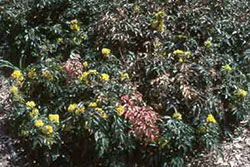Creeping grape holly is probably one of the most useful plants available to regional gardeners. It will thrive in any number of situations. This native plant grows abundantly in the foothills and upper mountains. Related species have been a part of our regional landscape for millions of years and can be categorized as “living fossils.” Several species have been discovered as fossils in the Oligocene beds of Creede and Florissant.
Are creeping grape holly’s perennials?
In our modern landscape, creeping grape holly stands out as one of a handful of native plants classified as broadleaf evergreens. Here is a plant for all seasons, with foliage that lasts month to month. This holly is the perfect addition to the garden, especially when you need a sturdy, reliable plant that doesn’t require extensive maintenance.
How big do creeping grape holly’s grow?

Creeping grape holly is a low-growing shrubby plant. It grows six to 12 inches high, but height is easily controlled by pruning, which will also encourage the plant to become fuller in width. The cut stems are very useful in winter holiday wreaths and arrangements. Fresh foliage appears in the spring, followed by yellow flowers that ultimately yield blue berries that are often used to make a flavorful jelly.
Where should I plant this?
Grow this plant in sun or shade; it really isn’t too fussy. Once established, the creeping grape holly requires very little water. An occasional shearing will keep it in bounds.
For more information, see the following Colorado State University Extension fact sheet(s).
- Fall and Winter Watering
- Xeriscaping: Ground Cover Plants
- Ground Cover Plants
- Trees and Shrubs for Mountain Areas



